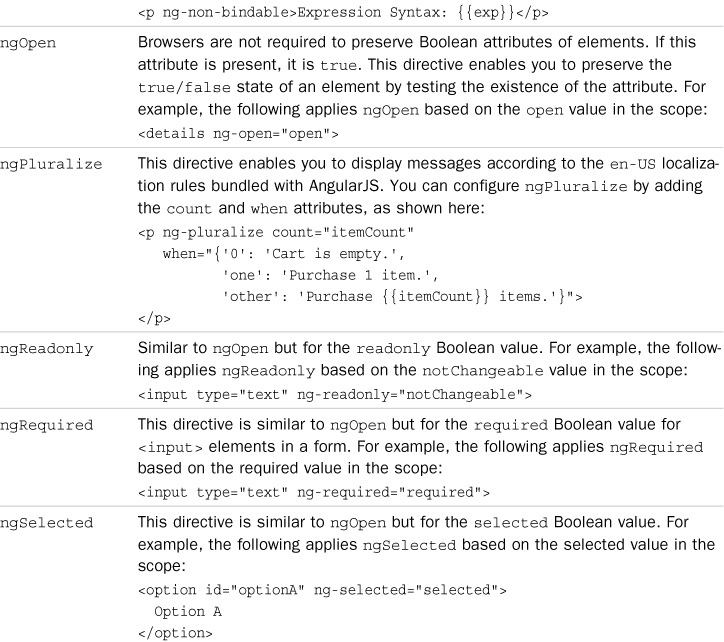Directives That Support AngularJS Functionality
Several directives provide support for AngularJS functionality. These directives do everything from bootstrapping an application to ensuring that Boolean expressions that AngularJS requires are preserved in the DOM.
Table 6.1 lists these directives and describes the behavior and usage of each.
The directives in Table 6.1 are used in different ways in various parts of the code. You have already seen a few of them such as ngApp and ngController used in previous examples. Some are fairly intuitive, such as using ng-src instead of src when implementing <img> elements in a template. Others will be used in various examples in subsequent chapters.
I did want to give you an example at this point of using the ngInclude directive. This little directive is simple to employ and can be used for a variety of purposes, especially if you are trying to introduce AngularJS into an existing system. In this example we will use ngInclude to swap the banner bar at the top of a basic web page by loading different partial HTML files from the server.
The code in Listing 6.1 implements a very basic AngularJS controller that stores an HTML filename in a variable named titleBar. The code in Listing 6.2 implements an AngularJS template that includes a couple of links at the top to switch pages and a <div> element on line 24 that using ng-include to change the contents of the div to the file specified by titleBar.
The different versions of the title bar are located in the files shown in Listings 6.3 and 6.4. Basically, these files just contain a <p> element that has either the large or small class assigned to it. The class definitions are located in the <style> element of Listing 6.2.
Figure 6.1 shows the two title banners. When the links are clicked to switch banners, the contents of the <div> element in the original are replaced by the new HTML file being loaded.
Listing 6.1 directive_angular_include.js: Implementing a Controller to Store the HTML Filename for a Title Element in the Scope
01 angular.module('myApp', []).
02 controller('myController', function($scope) {
03 $scope.titleBar = "small_title.html";
04 });
Listing 6.2 directive_angular_include.html: An AngularJS Template That Uses the nd-include Directive to Change the Title Bar of the Page by Swapping between Two HTML Files
01 <!doctype html>
02 <html ng-app="myApp">
03 <head>
04 <title>AngularJS Data Include Directive</title>
05 <style>
06 .large{
07 background-color: blue; color: white;
08 text-align: center;
09 font: bold 50px/80px verdana, serif;
10 border: 6px black ridge; }
11 .small{
12 background-color: lightgrey;
13 text-align: center;
14 border: 1px black solid; }
15 a{
16 color: blue; text-decoration: underline;
17 cursor: pointer; }
18 </style>
19 </head>
20 <body>
21 <div ng-controller="myController">
22 [<a ng-click="titleBar='large_title.html'">Make Title Large</a>]
23 [<a ng-click="titleBar='small_title.html'">Make Title Small</a>]
24 <div ng-include="titleBar"></div>
25 </div>
26 <script src="http://code.angularjs.org/1.3.0/angular.min.js"></script>
27 <script src="js/directive_angular_include.js"></script>
28 </body>
29 </html>
Listing 6.3 small_title.html: A Partial HTML File That Contains the Small Version of the Title
01 <p class="small">
02 This is a Small Title
03 </p>
Listing 6.4 large_title.html: A Partial HTML File That Contains the Large Version of the Title
01 <p class="large">
02 This is a Large Title
03 </p>?
Figure 6.1 Using the ng-include directive to dynamically change the view using different HTML partial files.




